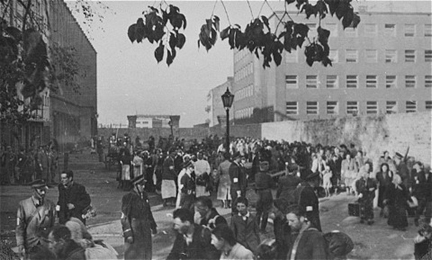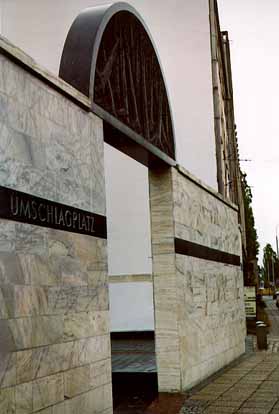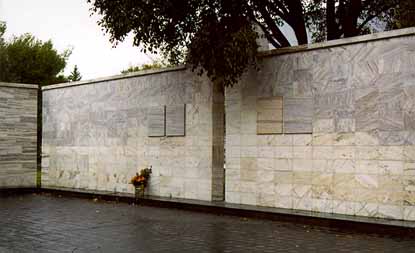The Umschlagplatz
 Umschlagplatz Monument
resembles railroad freight car
Umschlagplatz Monument
resembles railroad freight car
Pictured above is a memorial which has
been built on ul. Stawki at the spot where the Umschlagplatz
once stood, on the northern boundary of the Warsaw Ghetto. The
Umschlagplatz was where the Jews in the Warsaw Ghetto had to
assemble to board the trains which transported them to the death
camp at Treblinka,
beginning in July 1942.
The Jewish Ghettos, which the Nazis established
in all the major Jewish population centers of Poland, were part
of the systematic plan to get rid of all the Jews in Europe,
and were intended as a transitional measure. The next stage of
the plan was the liquidation of the Ghettos and "transportation
to the East."
On July 22, 1942 the Warsaw Ghetto was
surrounded by Ukrainian and Latvian soldiers in German SS uniforms,
as the liquidation of the Ghetto began in response to an order
given by Reichsführer-SS Heinrich Himmler that "the
resettlement of the entire Jewish population of the General Government
be carried out and completed by December 31." The General
Government was the central portion of the former country of Poland
that was occupied by the Germans between 1939 and 1944.
 Jews assemble at Umschlagplatz
for deporatation
Jews assemble at Umschlagplatz
for deporatation
Two days before, on July 20ieth, the
Judenrat (Jewish leaders) had been ordered to prepare for the
resettlement (Aussiedlung) of the "non-productive elements"
to the East. The Jews in the Warsaw Ghetto were to report voluntarily
to the Umschlagplatz (collection point) at the corner of Stawki
and Dzika streets, near a railroad siding for the Ostbahn (Eastern
Railroad), on which they would be "transported to the East"
on crowded freight cars. The old photograph above shows the location
of the Umschlagplatz. A monument has been erected on this spot,
as shown in the photo at the top of this page.
According to Raul Hilberg in his book,
The Destruction of the European Jews, "As soon as the order
was posted, a mad rush started for working cards. Many forgings
took place and in the ghetto, everyone from top to bottom was
frantic." A similar scene is depicted in the movie, Schindler's
List, when a Jewish professor in Krakow suddenly becomes an experienced
metal worker with forged papers, aged by tea stains.
The chairman of the Warsaw Jewish Council,
Adam Czerniakow, was ordered by the Nazis to deliver 6,000 Jews
per day, seven days a week, to the Umschlagplatz for deportation
to Treblinka
on the Bug river near the eastern border of German occupied Poland.
A day later, the number was increased to 7,000 per day. Rather
than cooperate with the Nazis, Czerniakow committed suicide on
July 23rd, the first day that Jews were assembled ready for deportation.
After Poland was conquered, following
the joint invasion by the Germans and the Soviet Union in September
1939, the Polish Army escaped to Romania and the Polish leaders
set up a government in exile in London. The Polish soldiers continued
to fight underground as partisans in the Polish Home Army.
Raul Hilberg wrote the following in his
book, The Destruction of the European Jews:
The Polish underground thereupon contacted
the Ghetto. The answer of the Jewish leaders was that perhaps
60,000 Jews would be deported, but that it was "inconceivable
that the Germans would destroy the lot." The Jews had one
request, which the Polish Home Army was glad to fulfill. They
handed to the Poles an "appeal addressed to the world and
to the Allied nations in particular." The Jewish leadership
demanded that the German people be threatened with reprisals.
The appeal was immediately transmitted to London, but the BBC
maintained complete radio silence. As we shall have occasion
to find out later, the Jews did not have many friends in London,
or for that matter, in Washington.
 Side view of Umschlagplatz
Memorial
Side view of Umschlagplatz
Memorial
The photo above shows a side view of
the memorial at the Umschlagplatz. According to my tour guide,
the design is supposed to represent a freight car with the door
open. This memorial is located right on the sidewalk of a very
busy street; notice the trolley car tracks on the street just
a few feet in front of it, which you can see in the photo at
the top of this page.
The photo below shows the interior of
the memorial with a single bouquet of flowers left by a visitor.
The inside is the same rectangular shape as a railroad freight
car, although much bigger. The 7,000 Jews who assembled here
daily were crowded into 60 freight cars for the train trip to
the Treblinka extermination center. The daily deportations continued
until Sept. 12, 1942.
 Inside of Umschlagplatz
Monument in Warsaw
Inside of Umschlagplatz
Monument in Warsaw
In his book "The Holocaust,"
Martin Gilbert wrote the following:
"In those seven weeks, a total
of 265,000 Jews were sent by train for 'resettlement in the East'.
Their actual destination was Treblinka and its three gas-chambers.
Death, not slave labour, was their fate. It was the largest slaughter
of a single community, Jewish or non-Jewish, in the Second World
War."
According to the most recent information
about Treblinka, there were originally three gas chambers there,
but 10 more were added later. The bodies were first buried in
mass graves and then dug up and burned on pyres.
According to the U.S. Holocaust Museum,
by the Summer of 1944, all the Jewish Ghettos in Eastern Europe
had been closed and two million Ghetto Jews had been transported
to concentration camps or death camps. The three main death camps
for the Ghetto Jews were the Operation Reinhard camps: Treblinka, Belzec and Sobibor, all of which were near the eastern
border of German occupied Poland.
Today guards are posted near the memorial,
but even so, the inside walls of this memorial had been defaced
with a Nazi swastika when I visited it in October 1998.
This page was last updated on April 18,
2008
|